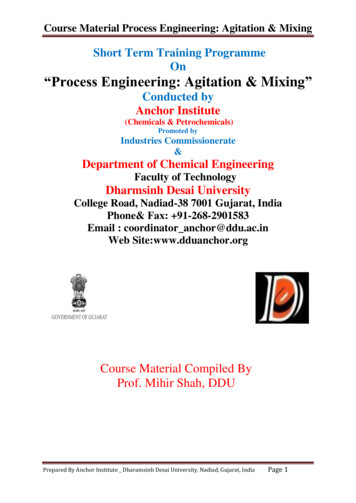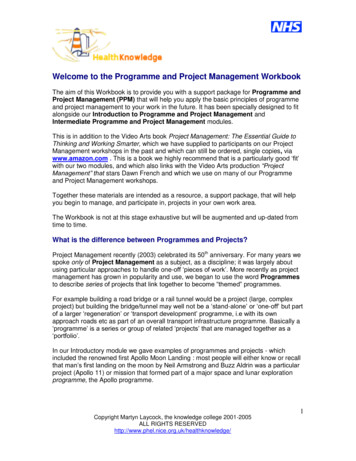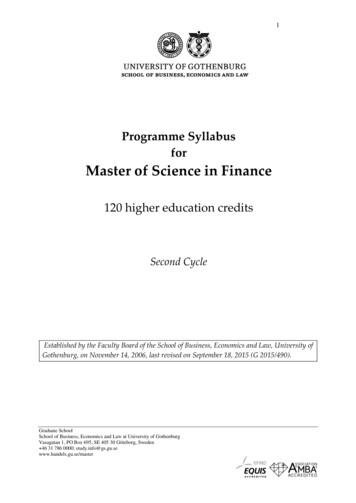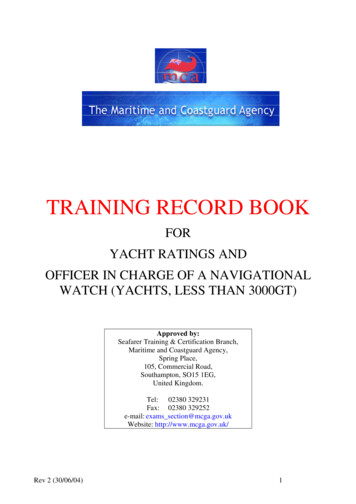
Transcription
Course Material Process Engineering: Agitation & MixingShort Term Training ProgrammeOn“Process Engineering: Agitation & Mixing”Conducted byAnchor Institute(Chemicals & Petrochemicals)Promoted byIndustries Commissionerate&Department of Chemical EngineeringFaculty of TechnologyDharmsinh Desai UniversityCollege Road, Nadiad-38 7001 Gujarat, IndiaPhone& Fax: 91-268-2901583Email : coordinator anchor@ddu.ac.inWeb Site:www.dduanchor.orgCourse Material Compiled ByProf. Mihir Shah, DDUPrepared By Anchor Institute Dharamsinh Desai University, Nadiad, Gujarat, IndiaPage 1
Course Material Process Engineering: Agitation & MixingPreface :The Anchor Institute Chemicals & Petrochemicals, Dharmsinh Desai University, Nadiad hasbeen actively involved in fulfilling its objective of designing and implementing Industryresponsive courses considering the need of Industry in this sector right from the beginning.The courses are designed in consultation with Industry and Academia. We have also preparedteaching, learning and reference material for all these courses for the use of Faculty members.Anchor Institute DDU has conducted 42 training courses involving participants 720 fromIndustry, 447 faculty members and 1186 students till October 2012. This consists of 21different subject Programmes as under.1. CDM and Carbon Trading in India.2. METLAB and its application.3. Prevention and Management of Chemical Hazards & accidents.4. Certificate course for Chemical Plant Operator.5. Scheduling & Optimization of Process Plants.6. Process Engineering (Debottlenecking & Time Cycle reduction).7. Energy Conservation in Chemical Industry.8. Advance Process Control Dynamics and Data analysis.9. Process Engineering (Agitation & Mixing).10. Use of animations in Chemical Engineering – Effective teaching learning process.11. Process Engineering (Vacuum Technology).12. Repair and Maintenance of Chemical Plant & Equipment.13. Industrial Chemical Technology.14. Energy conservation & audit.15. Stoichiometry for Chemical process plants.16. Chemical Process Simulations – Application of software in Chemical Industry.17. Performance enhancement of ETP.18. Chemical Engineering to non-chemical Engineers.19. Environment Management System ISI 14001-2004.20. Quality Management System ISO 9001-2008.21. Piping systems in Chemical Industry.It is our pleasure to present teaching, learning course material on “Process EngineeringAgitation & Mixing”Dr. P. A. JoshiChairman,Anchor Institute, DDUMr. S. J. VasavadaAssociate Coordinator,Anchor Institute DDUPrepared By Anchor Institute Dharamsinh Desai University, Nadiad, Gujarat, IndiaPage 2
Course Material Process Engineering: Agitation & MixingAnchor Institute- Chemicals & Petrochemicals SectorGujarat has witnessed rapid industrialization in the last two decades and has evolved as hub for Chemicals andPetrochemicals. In fact the State has become the petro capital of the country. Department of Chemicals &Petrochemicals under the Chemicals & Fertilizer Ministry of Government of India has signed memorandum ofagreement with the Government of Gujarat to set up a Petroleum, Chemicals and Petrochemicals InvestmentRegion (PCPIR) in the state at Dahej with estimated total proposed investment of Rs.50, 000 crore andexpected to provide employment to 8 lakh people that include 1.9 lakh of direct employment over a period oftime.Hence, developing the man power on a massive scale for this sector is the prime issue as realized by theIndustries Commissionerate, Government of Gujarat (I.C., GOG). The need for better quality and skilledtechnical manpower is increasing and will continue to increase in time to come. It therefore, has decided totackle this issue and took proactive approach through the industry responsive Training Courses and SkillDevelopment Programmes.We are pleased to inform you that I.C., GOG entrusted DDU to take up the challenge to be an AnchorInstitute for the fastest growing Chemicals & Petrochemicals sector of the state. Its Associates are L. D.College of Engineering, Ahmedabad as Co Anchor Institute, N. G. Patel Polytechnic, Afwa, Bardoli and ITIAnkleshwar as Nodal Institutes.The objective of the Anchor Institute and its Associates is to take various initiatives in creating readilyemployable and industry responsive Man Power, at all level for Chemicals & Petrochemicals sector across theState.To achieve the Objective our major proposed activities ahead are as under Identifying the training courses & skill development programs as per the need of the Chemical &Petrochemical Industries in Gujarat state for ITI, Diploma & Degree Level faculty members & students,SUCs, people in the industries, unemployed persons who are seeking jobs in this sector etc. Organizing faculty development programs (training for trainers) Mentoring and Assisting the Nodal Institutes. Benchmarking of the training courses Up-grading the Courses offered in Chemical & Petrochemical Engineering and make them Industryresponsive. Identifying new and emerging area in this field.With above activities, we expect that following will be the major beneficiaries Unemployed technical manpower having completed the formal study Technical manpower already in job Faculty members and students of the technical institutions Chemicals & Petrochemicals industriesTo accomplish this task, we involve the Experts from the Industries, consulting companies, , EngineeringCompanies & Trainers well known in this Sector.Prof. (Dr.) Shirish L. Shah, University of Alberta, Canada Addressing at A.P.C. Course module II at DDU Nov 21-26, 2010.Prepared By Anchor Institute Dharamsinh Desai University, Nadiad, Gujarat, IndiaPage 3
Course Material Process Engineering: Agitation & MixingPreambleAgitation is a means whereby mixing of phases can be accomplished and by which mass andheat transfer can be enhanced between phases or with external surfaces. In its most general sense, theprocess of mixing is concerned with all combinations of phases like Gas, Liquid, solid. It is the heartof the chemical industry.McCabe rightly quoted “Many processing operations depend for their success on the effectiveagitation & mixing of fluids”P I Industries ltd., Udaipur has wisely decided to give detailed exposure to this area to its Engineeringand R & D officers.I am sure that the identified Faculty members will deliver the lectures on the topics assigned tothem to the best of their capacity and expertise and put their best efforts to satisfy the thirst of theparticipants. This course is the outcome of discussions on various topics among Experts from P IIndustries Ltd and the expert faculty members for about 4 months. The entire course will cover thetopics the following topics arranged in sequential order so that all of you are benefited to the best way. Introduction to Agitation and Mixing Process Agitator Design Mixing Time Mixing of Liquid System Design of Gas Dispersion process Design of Solid Liquid Mixing Process Design of Solid-Solid Mixing ProcessThese topics are discussed in detail by the respective faculty members.At this Juncture, I also appeal all the participants to take full advantage of this learning and apply tothe operations where ever needed to improve the efficiency leading to improvement in quality andquantity of the products.I am thankful to Dr. H. M. Desai, Vice- Chancellor of Dharmsinh Desai University and mysource of Inspiration, Prof. (Dr.) P. A. Joshi, the Chairman of the Anchor Institute and former Dean ofFaculty of Technology and one of my best colleague since more than 35 years who has alwayssupported me not only in this endeavor but also others. I extend my thanks to the management of P IIndustries Ltd and Mr. Kamlesh Mehta, General Manager-Process development & Kapil Khanna,Manager – HR. I extend my gratitude to all the faculty members of Department of ChemicalEngineering , Faculty of Technology, Dharmsinh Desai University and from the field to accept myinvitation to join and spare their time , coming long a way and being with us to share their expertise.My sincere thanks are to Prof. Mihir P. Shah to help me in compiling this Course material to putbefore you on time.Prof. H R ShahEx. Coordinator,Anchor Institute- Chemicals & Petrochemicals.DDU, NadiadPrepared By Anchor Institute Dharamsinh Desai University, Nadiad, Gujarat, IndiaPage 4
Course Material Process Engineering: Agitation & MixingContents .1. Introduction to Agitation and Mixing Processa.b.c.d.e. .7Types of Mixing ProcessTypes of impellerTypes of flow in mixing vesselSelection of AgitatorsEnergy utilization in Different types of agitatorsBy: Dr.P.A.Joshi, DDU, Nadiad2. Agitator Designa. Introduction to Mixing Process Evaluation .31b. Calculation of Power requirement for Newtonian fluidc. Introduction to non-Newtonian fluid and power requirement for nonNewtonian fluidsd. Problems and Solution on power numbere. Shaft, Hub and Key DesignBy: Mihir P.Shah, DDU, Nadiad3. Mixing Time .62a. Discharge time from a batch reactorb. Mixing Time Calculationc. Problem and solution for Mixing TimeBy: Mihir P.Shah, DDU, Nadiad4. Mixing of Liquid System .79a.b.c.d.IntroductionSmall Blade High speed AgitatorsLarge Balde slow speed AgitatorsDesigning of impellere. ExamplesBy: Anand P.Dhanwani, DDU, Nadiad5. Design of Gas Dispersion processa.b.c.d. .87Background and industrial examplesScope of Gas-Liquid Dispersion processTypes of Gas-Liquid Mixing equipment and selectionFlow Regime in Gas-Liquid Mixing ProcessPrepared By Anchor Institute Dharamsinh Desai University, Nadiad, Gujarat, IndiaPage 5
Course Material Process Engineering: Agitation & Mixinge. Design of Gas-Liquid Dispersion processi. Power Numberii. Mixing Timeiii. Bubble Diameter and gas hold upiv. Mass Transfer Coefficientv. Mass Transfer with chemical reactionBy: Mihir P.Shah, DDU, Nadiad6. Design of Solid Liquid Mixing Process .116a.b.c.d.e.Scope of Solid-Liquid MixingUnit Operation Involving Solid-Liquid MixingKey Consideration in Solid-Liquid MixingHydrodynamics of solid suspensionSelection, scale-up, and design issues for solid–liquid mixingequipmentf. Recommendation of solid-liquid mixing equipmentsBy: Devesh J.Vyas, DDU, Nadiad7. Design of Solid-Solid Mixing Processa.b.c.d. .129IntroductionCharacteristic of powder MixingMechanism of Mixing ProcessSelection, Scale-up and design issues for solid-solid mixingequipmentBy: Devesh J.Vyas, DDU, Nadiad8. Scale-Up issues in Mixing Processa.b.c.d.e. .149IntroductionScale up of solid Mixing ProcessScale up of gas-liquid Mixing ProcessScale up of liquid-liquid Mixing ProcessDesign CalculationsBy: Mr. Ashok Chaurasia, FEDA, Inc.RefeRences .Faculty ProfilesPrepared By Anchor Institute Dharamsinh Desai University, Nadiad, Gujarat, India .158 .160Page 6
Course Material Process Engineering: Agitation & MixingChapter 1.MIXING AND AGITATIONAgitation is a means whereby mixing of phases can be accomplished and by which mass andheat transfer can be enhanced between phases or with external surfaces. In its most generalsense, the process of mixing is concerned with all combinations of phases of which the mostfrequently occurring ones are1. gases with gases.2. gases into liquids: dispersion.3. gases with granular solids: fluidization, pneumatic conveying, drying.4. liquids into gases: spraying and atomization.5. liquids with liquids: dissolution, emulsification, dispersion6. liquids with granular solids: suspension.7. pastes with each other and with solids.8. solids with solids: mixing of powders.Interactions of gases, liquids, and solids also may take place, as in hydrogenation of liquids inthe presence of a slurred solid catalyst where the gas must be dispersed as bubbles and thesolid particles must be kept in suspension.Three of the processes involving liquids, numbers 2, 5, and 6, employ the same kind ofequipment; namely, tanks in which the liquid is circulated and subjected to a certain amountof shear. This kind of equipment has been studied most extensively. Although some unusualcases of liquid mixing may require pilot plant testing, general rules have been developed withwhich mixing equipment can be designedsomewhat satisfactorily1. A BASIC STIRRED TANK DESIGNThe dimensions of the liquid content of a vessel and the dimensions and arrangement ofimpellers, baffles and other internals are factors that influence the amount of energy requiredfor achieving a needed amount of agitation or quality of mixing. The internal arrangementsdepend on the objectives of the operation: whether it is to maintain homogeneity of a reactingmixture or to keep a solid suspended or a gas dispersed or to enhance heat or mass transfer. Abasic range of design factors, however, can be defined to cover the majority of cases, forexample as in Figure 1.THE VESSELA dished bottom requires less power than a flat one. When a single impeller is to be used, aliquid level equal to the diameter is optimum, with the impeller located at the center for anall-liquid system. Economic and manufacturing considerations, however, often dictate higherratios of depth to diameter.Prepared By Anchor Institute Dharamsinh Desai University, Nadiad, Gujarat, IndiaPage 7
Course Material Process Engineering: Agitation & MixingFigure 1. A basic stirred tank design, not to scale, showing a lower radial impeller and anupper axial impeller housed in a draft tube. Four equally spaced baffles are standard. H height of liquid level, D, tank diameter, d impeller diameter. For radial impellers, 0.35d/D,50.6.BAFFLESExcept at very high Reynolds numbers, baffles are needed to prevent vortexing and rotationof the liquid mass as a whole. A baffle width one-twelfth the tank diameter, w Dt/12; alength extending from one half the impeller diameter, d/2, from the tangent line at the bottomto the liquid level, but sometimes terminated just above the level of the eye of the uppermostimpeller. When solids are present or when a heat transfer jacket is used, the baffles are offsetfrom the wall a distance equal to one- sixth the baffle width. Four radial baffles at equalspacing are standard; six are only slightly more effective, and three appreciably less so. Whenthe mixer shaft is located off center (one-fourth to one-half the tank radius), the resulting flowpattern has less swirl, and baffles may not be needed, particularly at low viscosities.DRAFT TUBESA draft tube is a cylindrical housing around and slightly larger in diameter than the impeller.Its height may be little more than the diameter of the impeller or it may extend the full depthof the liquid, depending on the flow pattern that is required. Usually draft tubes are used withaxial impellers to direct suction and discharge streams. An impeller-draft tube systembehaves as an axial flow pump of somewhat low efficiency. Its top to bottom circulationbehavior is of particular value in deep tanks for suspension of solids and for dispersion ofgases.Prepared By Anchor Institute Dharamsinh Desai University, Nadiad, Gujarat, IndiaPage 8
Course Material Process Engineering: Agitation & MixingIMPELLER TYPESA basic classification is into those that circulate the liquid axially and those that achieveprimarily radial circulation. Some of the many shapes that are being used will be describedshortly.IMPELLER SIZEThis depends on the kind of impeller and operating conditions described by the Reynolds,Froude, and Power numbers as well as individual characteristics whose effects have beencorrelated. For the popular turbine impeller, the ratio of diameters of impeller and vessel fallsin the range, d/Dt 0.3-0.6, the lower values at high rpm, in gas dispersion, for example.IMPELLER SPEEDWith commercially available motors and speed reducers, standard speeds are 37, 45, 56, 68,84, 100, 125, 155, 190, and 320 rpm. Power requirements usually are not great enough tojustify the use of continuously adjustable steam turbine drives. Two-speed drives may berequired when starting torques are high, as with a settled slurry.IMPELLER LOCATIONExpert opinions differ somewhat on this factor. As a first approximation, the impeller can beplaced at 1/6 the liquid level off the bottom. In some cases there is provision for changing theposition of the impeller on the shaft. For off-bottom suspension of solids, an impeller locationof 1/3 the impeller diameter off the bottom may be satisfactory. Criteria developed by Dickey(1984) are based on the viscosity of the liquid and the ratio of the liquid depth to the tankdiameter, h / Q .Whether one or two impellers are needed and their distances above the bottom of the tank areidentified in this table:Side entering propellers are placed 18-24 in. above a flat tank floor with the shaft horizontaland at a 10" horizontal angle with the centerline of the tank; such mixers are used only forviscosities below 500 CP or so.In dispersing gases, the gas should be fed directly below the impeller or at the periphery ofthe impeller. Such arrangements also are desirable for mixing liquids.2. KINDS OF IMPELLERSA rotating impeller in a fluid imparts flow and shear to it, the shear resulting from the flow ofone portion of the fluid past another. Limiting cases of flow are in the axial or radialdirections so that impellers are classified conveniently according to which of these flows isdominant. By reason of reflections from vessel surfaces and obstruction by baffles and otherinternals, however, flow patterns in most cases are mixed. When a close approach to axialPrepared By Anchor Institute Dharamsinh Desai University, Nadiad, Gujarat, IndiaPage 9
Course Material Process Engineering: Agitation & Mixingflow is particularly desirable, as for suspension of the solids as a slurry, the impeller may behoused in a draft tube; and when radial flow is needed, a shrouded turbine consisting of arotor and a stator may be employed.Because the performance of a particular shape of impeller usually cannot be predictedquantitatively, impeller design is largely an exercise of judgment so a considerable varietyhas been put forth by various manufacturers. A few common types are illustrated in Figure 2and are described as follows:a. The three-bladed mixing propeller is modeled on the marine propeller but has a pitchselected for maximum turbulence. They are used at relatively high speeds (up to 1800rpm)with low viscosity fluids, up to about 4000cP. Many versions are avail- able: with cutout orperforated blades for shredding and breaking up lumps, with saw tooth edges as in Figure2(g) for cutting and tearing action, and with other than three blades. The stabilizing ringshown in the illustration sometimes is included to minimize shaft flutter and vibrationparticularly at low liquid levels.b. The turbine with flat vertical blades extending to the shaft is suited to the vast majority ofmixing duties up to 100,000CP or so at high pumping capacity. The simple geometry of thisdesign and of the turbines of Figures 2(c) and (d) has inspired extensive testing so thatprediction of their performance is on a more rational basis than that of any other kind ofimpeller.c. The horizontal plate to which the impeller blades of this turbine are attached has astabilizing effect. Backward curved blades may be used for the same reason as for type e.d. Turbine with blades are inclined 45o (usually). Constructions with two to eight blades areused, six being most common. Combined axial and radial flow are achieved. Especiallyeffective for heat exchange with vessel walls or internal coils.e. Curved blade turbines effectively disperse fibrous materials without fouling. The sweptback blades have a lower starting torque than straight ones, which is important when startingup settled slurries.f. Shrouded turbines consisting of a rotor and a stator ensure a high degree of radial flow andshearing action, and are well adapted to emulsification and dispersion.g. Flat plate impellers with saw tooth edges are suited to emulsification and dispersion.Since the shearing action is localized, baffles are not required. Propellers and turbines alsoare sometimes provided with saw tooth edges to improve shear.h. Cage beaters impart a cutting and beating action. Usually they are mounted on the sameshaft with a standard propeller. More violent action may be obtained with spinned blades.i. Anchor paddles fit the contour of the container, prevent sticking of pasty materials, andpromote good heat transfer with the wall.j. Gate paddles are used in wide, shallow tanks and for materials of high viscosity when lowshear is adequate. Shaft speeds are low. Some designs include hinged scrapers to clean thesides and bottom of the tank.Prepared By Anchor Institute Dharamsinh Desai University, Nadiad, Gujarat, IndiaPage 10
Course Material Process Engineering: Agitation & Mixingk. Hollow shaft and hollow impeller assemblies are operated at high tip speeds forrecirculating gases. The gas enters the shaft above the liquid level and is expelledcentrifugally at the impeller. Circulation rates are relatively low, but satisfactory for somehydrogenations for instance.l. This arrangement of a shrouded screw impeller and heat exchange coil for viscous liquidsis perhaps representative of the many designs that serve special applications in chemicalprocessing.3. CHARACTERIZATION OF MIXING QUALITYAgitation and mixing may be performed with several objectives:1. Blending of miscible liquids.2. Dispersion of immiscible liquids.3. Dispersion of gases in liquids.4. Suspension of solid particles in a slurry.5. Enhancement of heat exchange between the fluid and the boundary of a container.6. Enhancement of mass transfer between dispersed phases.When the ultimate objective of these operations is the carrying out of a chemical reaction, theachieved specific rate is a suitable measure of the quality of the mixing. Similarly theachieved heat transfer or mass transfer coefficients are measures of their respectiveoperations. These aspects of the subject are not covered here. Here other criteria will beconsidered.Prepared By Anchor Institute Dharamsinh Desai University, Nadiad, Gujarat, IndiaPage 11
Course Material Process Engineering: Agitation & MixingFigure 2. Types of ImpellersThe uniformity of a multiphase mixture can be measured by sampling of several regions inthe agitated mixture. The time to bring composition or some property within a specified rangePrepared By Anchor Institute Dharamsinh Desai University, Nadiad, Gujarat, IndiaPage 12
Course Material Process Engineering: Agitation & Mixing(say within 95 or 99% of uniformity) or spread in values-whichtaken as a measure of mixing performance.is the blend time-may beVarious kinds of tracer techniques may be employed, for example:A dye is introduced and the time for attainment of uniform color is noted. A concentrated saltsolution is added as tracer and the measured electrical conductivity tells when thecomposition is uniform. The color change of an indicator when neutralization is completewhen injection of an acid or base tracer is employed.The residence time distribution is measured by monitoring the outlet concentration of an inerttracer that can be analyzed for accuracy. The shape of response curve is compared with thatof a thoroughly (ideally) mixed tank.Figure 3. Dimensionless blend time as a function of Reynolds number for pitched turbineimpellers with six blades whose WID 1/5.66 [Dickey and Fenic, Chem. Eng. 145, (5Jan.1976)l.In most cases, however, the RTDs have not been correlated with impeller characteristics orother mixing parameters. Largely this also is true of most mixing investigations, but Figure 3is an uncommon example of correlation of blend time in terms of Reynolds number for thepopular pitched blade turbine impeller. As expected, the blend time levels off beyond acertain mixing intensity, in this case beyond Reynolds numbers of 30,000 or so. The acidbase indicator technique was used. Other details of the test work and the scatter of the dataare not revealed in the published information.An impeller in a tank functions as a pump that delivers a certain volumetric rate at eachrotational speed and corresponding power input. The power input is influenced also by thegeometry of the equipment and the properties of the fluid. The flow pattern and the degree ofturbulence are key aspects of the quality of mixing. Basic impeller actions are either axial orradial, but, as Figure 4 shows, radial action results in some axial movement by reason ofdeflection from the vessel walls and baffles. Baffles contribute to turbulence by preventingswirl of the contents as a whole and elimination of vortexes; offset location of the impellerhas similar effects but on a reduced scale.Prepared By Anchor Institute Dharamsinh Desai University, Nadiad, Gujarat, IndiaPage 13
Course Material Process Engineering: Agitation & MixingFigure 4. Agitator flow patterns. (a) Axial or radial impellers without baffles producevortexes. (b) Off center location reduces the vortex. (c) Axial impeller with baffles. (d)Radial impeller with baffles.Power input and other factors are interrelated in terms of certain dimensionless groups. Themost pertinent ones are, in common units:NRe 10.75Nd2S/µ,Reynolds number, (10.1)NP 1.523(1013)P/N3d5S, Power number, (10.2)NQ 1.037(105)Q/Nd3,Flow number, (10.3)tbN,Dimensionless blend time, (10.4)NFr 7.454(10-4)N2d, Froude number, (10.5)d impeller diameter (in.),D vessel diameter (in.),N rpm of impeller shaft,P horsepower input,Q volumetric pumping rate (cuft/sec),S specific gravity,tb blend time (min),µ viscosity (cP).The Froude number is pertinent when gravitational effects are significant, as in vortexformation; in baffled tanks its influence is hardly detectable. The power, flow, and blend timenumbers change with Reynolds numbers in the low range, but tend to level off above NRe 10,000 or so at values characteristic of the kind of impeller. Sometimes impellers arecharacterized by their limiting Np as an Np 1.37 of a turbine, for instance. The dependencieson Reynolds number are shown on Figures 5 and 6 for power, in Figure 3 for flow and inFigure 7 for blend time.Rough rules for mixing quality can be based on correlations of power input and pumping ratewhen the agitation system is otherwise properly designed with a suitable impeller(predominantly either axial or radial depending on the process) in a correct location, withappropriate baffling and the correct shape of vessel. The power input per unit volume or thePrepared By Anchor Institute Dharamsinh Desai University, Nadiad, Gujarat, IndiaPage 14
Course Material Process Engineering: Agitation & Mixingsuperficial linear velocity can be used as measures of mixing intensity. For continuous flowreactors, for instance, a rule of thumb is that the contents of the vessel should be turned overin 5 to 10 % of the residence time. Specifications of superficial linear velocities for differentkinds of operations are stated later. For baffled turbine agitation of reactors, power inputs andimpeller tip speeds such as the following may serve as guide:4. POWER CONSUMPTION AND PUMPING RATEThese basic characteristics of agitation systems are of paramount importance and have beeninvestigated extensively. The literature is reviewed, for example, by Oldshue (1983, pp. 155191), Uhl and Gray (1966, Vol. l), and Nagata (1975). Among the effects studied are those oftype and dimensions and locations of impellers, numbers and sizes of baffles, and dimensionsof the vessel. A few of the data are summarized on Figures 5-7. Often it is convenient tocharacterize impeller performance by single numbers; suitable ones are the limiting values ofthe power and flow numbers at high Reynolds numbers, above 10,000-30,000 or so, forexampleFigure 5. Power number, N, Pg,/N3D5p, against Reynolds number, NRe NDzp/p, forseveral kinds of impellers: (a) helical shape (Oldshue, 1983); (b) anchor shape (Oldshue,1983); (c) several shapes: (1) propeller, pitch equalling diameter, without baffles; (2)propeller, s d, four baffles; (3) propeller, s 2d, without baffles; (4) propeller, s 2d, fourPrepared By Anchor Institute Dharamsinh Desai University, Nadiad, Gujarat, IndiaPage 15
Course Material Process Engineering: Agitation & Mixingbaffles; (5) turbine impeller, six straight blades, without baffles; (6) turbine impeller, sixblades, four baffles; (7) turbine impeller, six curved blades, four baffles; (8) arrowheadturbine, four baffles; (9) turbine impeller, nclined curved blades, four baffles; (10) two-bladepaddle, four baffles; (11) turbine impeller, six blades, four baffles; (12) turbine impeller withstator ring; (13) paddle without baffles (data of Miller and Mann); (14) paddle without baffles(data of White and Summerford). All baffles are of width 0.1D [afterRushton, Costich, andEverett, Chem. Eng. Prog. 46(9), 467 (1950)lFigure 5 (continued)A correlation of pumping rate of pitched turbines is shown as Figure 7.Power input per unit volume as a measure of mixing intensity or quality was cited in Section3. From the correlations cited in this section, it is clear that power input and Reynolds numbertogether determine also the pumping rate of a given design of impeller. This fact has beenmade the basis of a method of agitator system design by the staff of Chemineer. Thesuperficial linear velocity-the volumetric pumping rate per unit cross section of the tank-isadopted as a measure of quality of mixing. Table 2 relates the velocity toperformance of three main categories of mixing: mixing of liquids, suspension of solids inslurries, and dispersion of gases. A specification of a superficial velocity will enable selectionof appropriate impeller size, rotation speed, and power input with the aid of charts such asFigures 6 and 7.Prepared By Anchor Institute Dharamsinh Desai University, Nadiad, Gujarat, IndiaPage 16
Course Material Process Engineering: Agitation & MixingFigure 6. Power nu
Chemical Process Simulations – Application of software in Chemical Industry. . c. Types of Gas-Liquid Mixing equipment and selection d. Flow Regime in Gas-Liquid Mixing Process . . c. Mechanism of Mixing Process d. Selection, Scale-up and design issues for solid-solid mixing











